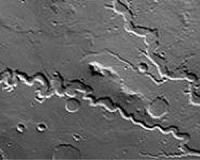 |
Tucson AZ (SPX) Dec 16, 2009 Catherine Weitz, a senior scientist at the Tucson-based Planetary Science Institute, has reported new evidence for multiple, water-related geologic processes on Mars. She and her colleagues studied light-toned deposits (LTDs) within troughs of the Noctis Labyrinthus region in western Valles Marineris using data gathered by three Mars Reconnaissance Orbiter (MRO) instruments: the High Resolution Imaging Science Experiment (HiRISE) camera, the Context Camera (CTX) and the Compact Reconnaissance Imaging Spectrometer for Mars (CRISM). Weitz presented the research results during a morning session of the American Geophysical Union Conference in San Francisco, Calif. "We analyzed ten troughs containing well-exposed LTDs, and we found a lot of variability that we didn't expect to see," she said. "We found that each of the troughs with LTDs has a unique mineralogy, and, therefore, the processes occurring in each trough were very localized." Weitz and her team identified various types of clays, hydrated silicas, and sulfates in these small basins, which are typically 30 to 100 kilometers across. One LTD included dozens of beds of varying thickness, brightness, color and erosional structure, suggesting that significant amounts of water once existed there. In addition, sulfates were mixed with clays within the deposits, indicating that ph levels may have fluctuated between acidic and alkaline conditions. Another LTD is buried several meters beneath wind-deposited material and is only exposed in the trough's upper walls, indicating it is older than the trough. In still another area, clays are buried beneath younger plains along the trough floor, while in the same trough, but a few kilometers away, there are exposures of hydrated silica and calcium sulfate. The wide variability in deposits and mineralogy in these and the other basins suggests a complex hydrologic history, including multiple events in some troughs, Weitz said. "Clearly, these areas were affected by water," she added. "In some cases there had to be multiple events. But we don't know how much water was involved or whether it was always a flowing liquid." "It might have been groundwater coming from Tharsis, the large volcanic complex to the west," she said. "There could have been active volcanism that produced water by melting snow, ice, or underground, hydrothermal processes. These little basins could then have filled or partially filled with some of that water. Another possibility is that material was already in several of the troughs, perhaps as volcanic ash or lava flows, and some kind of hydrothermal activity may have altered these pre-existing deposits." Weitz and her colleagues identified LTDs using the wide-range CTX camera that covers about a 30 km swath at a spatial resolution of 6 meters per pixel. Then they zeroed in on the areas of interest using HiRISE visible light images that cover about a 5-km-wide area with a resolution of about 26 centimeters per pixel. Finally, the corresponding CRISM data - in the visible and near infrared regions - revealed the hydrated minerals within each LTD. "It's great to have these complementary data sets," Weitz said. "Together, the synthesis of these three data sets provides valuable morphologic and mineralogic information needed to interpret the geologic setting and origin of the light-toned deposits within the troughs of Noctis." The LTDs both pre-date and post-date trough formation and occurred between the Noachian (4.6 to 3.5 million years ago) and Amazonian (1.8 billion years ago to the present) eras. The sediments in the LTDs could have formed at the bottom of lakes or pools, but materials also could have been deposited by the wind or fallen as volcanic ash and then been altered by water. Noctis Labyrinthus is a region of Mars that's located between the volcanic Tharsis upland and Valles Marineris, a huge system of canyons. Those working with Weitz on the research include Janice Bishop, of SETI Institute/NASA Ames; Leah Roach, of Frontier Technology; Ralph Milliken, of the Jet Propulsion Laboratory/Caltech; and J. Alexis Rodriguez, of the Planetary Science Institute. Share This Article With Planet Earth
Related Links Planetary Science Institute Mars News and Information at MarsDaily.com Lunar Dreams and more
 The Meandering Channels Of Mars
The Meandering Channels Of MarsMoffett Field CA (SPX) Dec 11, 2009 The surface of Mars is littered with channels that appear to be the work of ancient water flows. Indeed, some of these channels meander back and forth like slow-moving streams on our planet. Channels can be carved by lava, wind and glaciers, but these processes can't explain all the features on Mars. "We've gotten over the hump and can now agree that water flowed on the martian surface in ... read more |
|
| The content herein, unless otherwise known to be public domain, are Copyright 1995-2009 - SpaceDaily. AFP and UPI Wire Stories are copyright Agence France-Presse and United Press International. ESA Portal Reports are copyright European Space Agency. All NASA sourced material is public domain. Additional copyrights may apply in whole or part to other bona fide parties. Advertising does not imply endorsement,agreement or approval of any opinions, statements or information provided by SpaceDaily on any Web page published or hosted by SpaceDaily. Privacy Statement |